Artificial diamonds and the snowflake chamber, pt. 1
"It's summer in southern California, and among the palms and lemon trees a man is making snow," New Scientist writes. "Inside the physics department at Caltech in Pasadena, Kenneth Libbrecht grows tiny, frozen crystals."
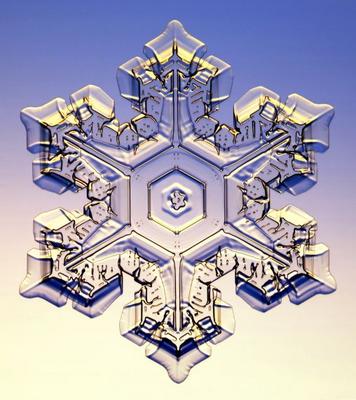
Using these manmade snowflakes, Libbrecht hopes to discover "why no two snowflakes are ever the same shape, and why they form myriad patterns of plates and needles and ferns and elaborate baroque stars."
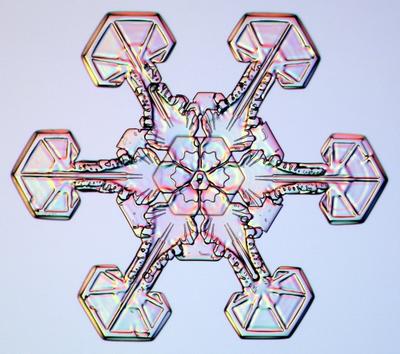
Wounded hexagons.
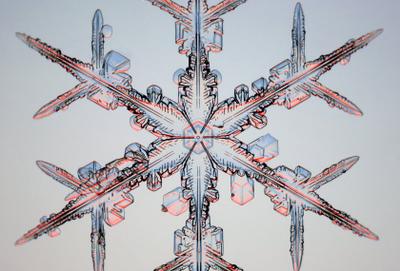
This is "the art of growing ice by electricity," and it "started in 1997 as an aesthetic quest."
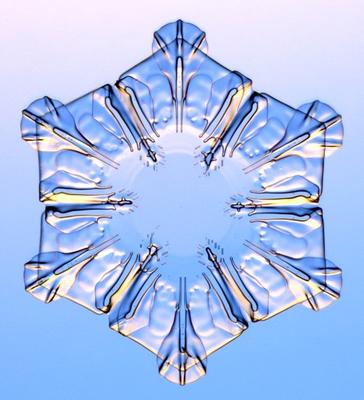
Libbrecht, in fact, has built "a snowflake incubation chamber – a steel cylinder about half a metre across with a few tubes attached. Look through a window in the side, and you can see an embryonic snowflake growing on the end of an ice needle."

This "incubation chamber" is really a kind of snowflake printer: "Libbrecht can make any of the fantastic natural shapes that fall... If he wants a plain, flat plate or a many-fingered dendrite, he just presses a few buttons, waits a few minutes, and [whoop!] there it is."
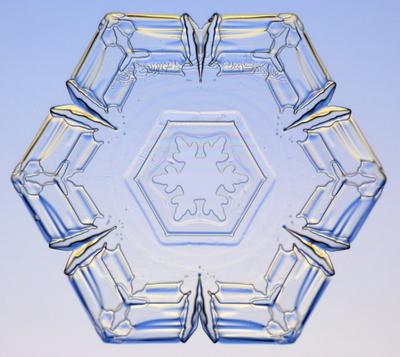
(All quotations from "Designer Snowflakes" in the 23 December 2000 issue of New Scientist. For another article, click here; and for a lecture by Libbrecht in Culver City, CA, home of the Center for Land Use Interpretation, click here. For loads of beautiful snowflake images go here. Finally, for some quite remarkable stereoscopic images of black-and-white, electro-alien high-tech snowflakes click here [the fifth from the top is insane].)
Kenneth Libbrecht, it seems, has some very interesting interests (including helioseismology).
In any case, Ukichiro Nakaya, at Hokkaido University, was also in on the snowflake incubation act – he's even got a "museum of snow" named after him, apparently designed by Arata Isozaki. (Ken Libbrecht himself took a "snow crystal tour" in 2002, including a stop at the Nakaya museum.)

[Nakaya's chart of snow crystallography.]
Snowflakes have temperature thresholds, Nakaya realized, highs and lows a baby flake cannot cross: "If the flake teeters back and forth between these two temperatures, it will grow fast then slow, as the arm-growing mechanism turns on and off. The resulting complicated, unpredictable series of branchings eventually becomes a beautiful, classical snowflake."
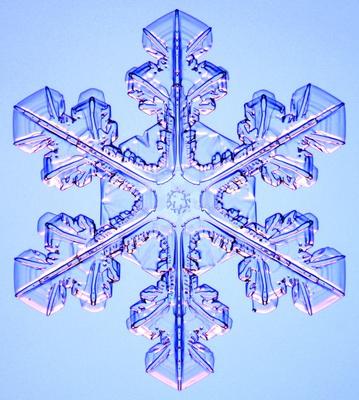
In this context, another New Scientist article – "Which kind of snow?" from 23 December 2000 – follows Bill Wergin, at the U.S. Agricultural Research Service, who photographs and catalogs individual snowflakes after "coating them with a thin layer of platinum."
"The result is fantastically detailed images of snowflakes in their pristine state" – albeit snowflakes in a metallized state, but no matter. (See here for some of his freaky images – and, yes, that is snow.)
Metallized symmetry; elaborate baroque stars; snowflake incubation chambers...
I'm tempted here to propose a new BLDGBLOG project: the snow incubation city. It would be styled after baroque Rome –
–
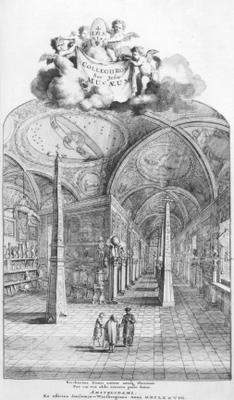
– and built entirely of snowflake incubation chambers. Within the marble domes and vaulted corridors, buttressed galleries lined with alcoves, inside the hollow columns of spiral stairs and tunneled foundations beneath gardens and their decaying granite statuary, ringed around the city like the flower warehouses of outer Holland, snow would always fall, in steady curtains or random flakes, filling up the insides of buildings; and you could wake up in the middle of the night and go walking past the windows of locked skyscrapers and abandoned churches, inside of which snow is falling, and you could explore the vast ballrooms and corporate lobbies of a moonlit world, catching wounded hexagons and frozen plates and needles of snow on your shoulders and on the backs of your hands.
(And if you don't already know it, check out The Snow Show, where Zaha Hadid, Lebbeus Woods, Tadao Ando, even Anish Kapoor, built a city out of ice in Norway – and it's happening again this year.)
I'm reminded of two things: 1) the movie *Real Genius* (a film bearing the rather embarrassing tagline: "When he gets mad, he doesn't get even... he gets creative"), because they build a tobogganing run out of artificial ice in the hallways of a Caltech dorm – though I'd hope that BLDGBLOG's snow city could be at least a little more interesting.
And, 2) I went to a concert once in the Zionskirche, in Zionskirchplatz on the border between Mitte and Prenzlauer Berg in Berlin – this was back in the summer of 2000 – and it was nearly midnight, and a choir was there, but the church hadn't been maintained so the ceiling, throughout the concert – which was candlelit, and sounded like Arvo Pärt – the ceiling was snowing small white flakes of plaster on the choir as they sang. The inside of the church was snowing on us. The exact mathematical dimensions of angels.
Well – part 2 coming up soon.
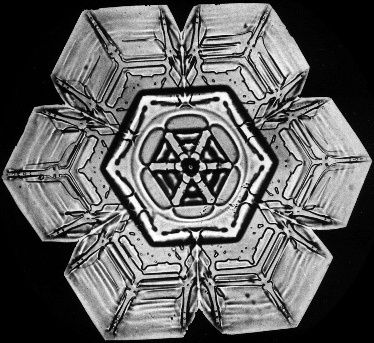
[Image: An early snow photograph, by Wilson Bentley.]

Using these manmade snowflakes, Libbrecht hopes to discover "why no two snowflakes are ever the same shape, and why they form myriad patterns of plates and needles and ferns and elaborate baroque stars."

Wounded hexagons.

This is "the art of growing ice by electricity," and it "started in 1997 as an aesthetic quest."

Libbrecht, in fact, has built "a snowflake incubation chamber – a steel cylinder about half a metre across with a few tubes attached. Look through a window in the side, and you can see an embryonic snowflake growing on the end of an ice needle."

This "incubation chamber" is really a kind of snowflake printer: "Libbrecht can make any of the fantastic natural shapes that fall... If he wants a plain, flat plate or a many-fingered dendrite, he just presses a few buttons, waits a few minutes, and [whoop!] there it is."

(All quotations from "Designer Snowflakes" in the 23 December 2000 issue of New Scientist. For another article, click here; and for a lecture by Libbrecht in Culver City, CA, home of the Center for Land Use Interpretation, click here. For loads of beautiful snowflake images go here. Finally, for some quite remarkable stereoscopic images of black-and-white, electro-alien high-tech snowflakes click here [the fifth from the top is insane].)
Kenneth Libbrecht, it seems, has some very interesting interests (including helioseismology).
In any case, Ukichiro Nakaya, at Hokkaido University, was also in on the snowflake incubation act – he's even got a "museum of snow" named after him, apparently designed by Arata Isozaki. (Ken Libbrecht himself took a "snow crystal tour" in 2002, including a stop at the Nakaya museum.)

[Nakaya's chart of snow crystallography.]
Snowflakes have temperature thresholds, Nakaya realized, highs and lows a baby flake cannot cross: "If the flake teeters back and forth between these two temperatures, it will grow fast then slow, as the arm-growing mechanism turns on and off. The resulting complicated, unpredictable series of branchings eventually becomes a beautiful, classical snowflake."

In this context, another New Scientist article – "Which kind of snow?" from 23 December 2000 – follows Bill Wergin, at the U.S. Agricultural Research Service, who photographs and catalogs individual snowflakes after "coating them with a thin layer of platinum."
"The result is fantastically detailed images of snowflakes in their pristine state" – albeit snowflakes in a metallized state, but no matter. (See here for some of his freaky images – and, yes, that is snow.)
Metallized symmetry; elaborate baroque stars; snowflake incubation chambers...
I'm tempted here to propose a new BLDGBLOG project: the snow incubation city. It would be styled after baroque Rome

– and built entirely of snowflake incubation chambers. Within the marble domes and vaulted corridors, buttressed galleries lined with alcoves, inside the hollow columns of spiral stairs and tunneled foundations beneath gardens and their decaying granite statuary, ringed around the city like the flower warehouses of outer Holland, snow would always fall, in steady curtains or random flakes, filling up the insides of buildings; and you could wake up in the middle of the night and go walking past the windows of locked skyscrapers and abandoned churches, inside of which snow is falling, and you could explore the vast ballrooms and corporate lobbies of a moonlit world, catching wounded hexagons and frozen plates and needles of snow on your shoulders and on the backs of your hands.
(And if you don't already know it, check out The Snow Show, where Zaha Hadid, Lebbeus Woods, Tadao Ando, even Anish Kapoor, built a city out of ice in Norway – and it's happening again this year.)
I'm reminded of two things: 1) the movie *Real Genius* (a film bearing the rather embarrassing tagline: "When he gets mad, he doesn't get even... he gets creative"), because they build a tobogganing run out of artificial ice in the hallways of a Caltech dorm – though I'd hope that BLDGBLOG's snow city could be at least a little more interesting.
And, 2) I went to a concert once in the Zionskirche, in Zionskirchplatz on the border between Mitte and Prenzlauer Berg in Berlin – this was back in the summer of 2000 – and it was nearly midnight, and a choir was there, but the church hadn't been maintained so the ceiling, throughout the concert – which was candlelit, and sounded like Arvo Pärt – the ceiling was snowing small white flakes of plaster on the choir as they sang. The inside of the church was snowing on us. The exact mathematical dimensions of angels.
Well – part 2 coming up soon.

[Image: An early snow photograph, by Wilson Bentley.]

Comments are moderated.
If it's not spam, it will appear here shortly!
my blog-brother you have way too much time on your hands..good on you
Nakaya's first experiments to grow snow crystals were all failures. He didn't have the correct substrate: he tried spiderwebs, various plant fibers, thin strings of metal, even human hair. The result was always a band of frost rather than a snow crystal clinging to a single point on the substrate. Finally, fur from a species of rabbit native to Hokkaido did the trick!
I would only ask that your Baroque snow crystal chamber be a habitat for these rabbits, and that each of their hairs support a unique snow crystal...
Bellissimo! Bellissimo!
Post a Comment